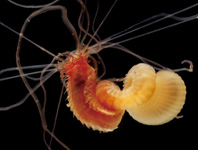Abstract
We describe Tuccioglyphus setosus gen. et sp. nov. from the litter of commercially reared laying hens as well as wild birds in Brazil. The new genus Tuccioglyphus presents a mixture of character states between the two conventional subfamilies, Pyroglyphinae and Dermatophagoidinae. Based on this new unusual genus, we discuss character states delimiting these and other major subfamilies of the house dust mite family, Pyroglyphidae, as well as its most important and species-rich genus Dermatophagoides. An additional new genus, Marioglyphus gen. n., is proposed for Hughesiella valerioi Vargas and Smiley. Both Tuccioglyphus and Marioglyphus are related to the genus Hughesiella. A key to pyroglyphid genera of the World is presented.
References
Arlian, L.G. (1991) House-dust-mite allergens: a review. Experimental & Applied Acarology, 10, 167–186.
https://doi.org/10.1007/BF01198649Atyeo, W.T. & Gaud, J. (1966) The chaetotaxy of sarcoptiform feather mites (Acarina: Analgoidea). Journal of the Kansas Entomological Society, 39, 337–346.
Bochkov, A.V., Klimov, P.B. & Grootaert, P. (2014) Revision of the subfamily Onychalginae Fain, 1988 (Acariformes: Pyroglyphidae)-ectoparasites of passerine birds. Zootaxa, 3785 (2), 175–200.
https://doi.org/10.11646/zootaxa.3785.2.3Cunnington, A.M. & Gregory, P.H. (1968) Mites in bedroom air. Nature, 217, 1271–1272.
https://doi.org/10.1038/2171271a0Evans, G.O. (1992) Principles of Acarology. University Press, Cambridge, London, 563 pp.
Fain, A. (1990) Morphology, systematics and geographical distribution of mites responsible for allergic disease in man. In: Guerin, B. (Ed.), Mites and Allergic Disease. Allerbio, Varennes-en-Argonne, pp. 11–134.
Fain, A. & Atyeo, W.T. (1990) A new pyroglyphid mite (Acari: Pyroglyphidae) from a woodpecker (Picidae) in Thailand. Acarologia, 31, 43–50.
Gaud, J. & Atyeo, W.T. (1996) Feather mites of the World (Acarina, Astigmata): the supraspecific taxa. Part 1. Text. Koninklijk Museum voor Midden Afrika / Tervuren Belgie Annalen Zoologische Wetenschappen, 277, 1–193.
Griffiths, D.A., Atyeo, W.T., Norton, R.A. & Lynch, C.A. (1990) The idiosomal chaetotaxy of astigmatid mites. Journal of Zoology, 220, 1–32.
https://doi.org/10.1111/j.1469-7998.1990.tb04291.xGriffiths, D.A. & Cunnington, A.M. (1971) Dermatophagoides microceras sp. n.: a description and comparison with its sibling species, D. farinae Hughes. Journal of Stored Products Research, 7, 1–14.
https://doi.org/10.1016/0022-474X(71)90032-4Hughes, A.M. (1976) The mites of stored food and houses. Her Majesty's Stationery Office, London, 400 pp.
Klimov, P.B., Bochkov, A.V. & OConnor, B.M. (2016) Phylogenetic position of the house dust mite subfamily Guatemalichinae (Acariformes: Pyroglyphidae) based on integrated molecular and morphological analyses and different measures of support. Cladistics, 32, 261–275.
https://doi.org/10.1111/cla.12126Klimov, P.B. & OConnor, B.M. (2013) Is permanent parasitism reversible?—Critical evidence from early evolution of house dust mites. Systematic Biology, 62, 411–423.
https://doi.org/10.1093/sysbio/syt008Lloyd, C.M. (2009) Dust mites' dirty dealings in the lung. Nature Medicine, 15, 366–367.
https://doi.org/10.1038/nm0409-366Norton, R.A. (1998) Morphological evidence for the evolutionary origin of Astigmata (Acari: Acariformes). Experimental and Applied Acarology, 22, 559–594.
https://doi.org/10.1023/A:1006135509248Norton, R.A. & Behan-Pelletier, V.M. (2009) Chapter 15. Oribatida. In: Krantz, G.W. & Walter, D.E. (Eds.), A Manual of Acarology. 3rd Edition. Texas Tech University Press, Lubbock, Texas, pp. 430–564.
Tovey, E.R., Chapman, M.D. & Platts-Mills, T.A. (1981) Mite faeces are a major source of house dust allergens. Nature, 289, 592–593.
https://doi.org/10.1038/289592a0Tucci, E.C., Bruno, T.V. & Guimarães, J.H. (1989) Armadilha para amostragem de Dermanyssus gallinae (Acari: Dermanyssidae) em aviários de postura comercial. Arquivos do Instituto Biologico, São Paulo, 56 (Supplement), 114.

